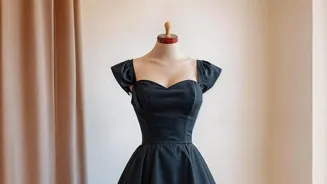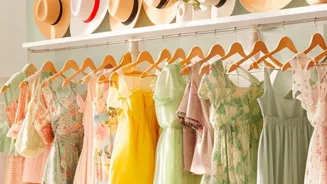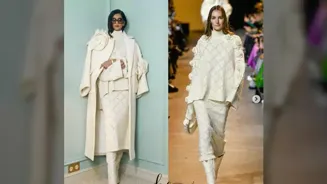Dive into the World of Haute Couture: Unraveling the Art, Craftsmanship, and Luxury. Explore the allure of this exclusive realm
Haute couture, a French term meaning "high sewing" or "high fashion," represents
the pinnacle of the fashion world. It's more than just expensive clothing; it's an art form, a legacy of craftsmanship, and a symbol of ultimate luxury.
For those unfamiliar with its intricacies, haute couture can seem like an exclusive and mysterious realm. So, let's unravel the threads of this fascinating world and explore what makes it so special.
From the rigorous requirements to its historical roots, discover everything you need to know about haute couture.
French haute couture defined by strict criteria for luxury fashion houses
First, let's break down what qualifies a fashion house as "haute couture." It's not simply a matter of price or celebrity endorsement.
In France, the term is legally protected and regulated by the "Chambre Syndicale de la Haute Couture," an organization under the umbrella of the French Federation of Fashion. To earn the label, a designer must meet strict criteria.
These criteria include designing made-to-order clothes for private clients, with one or more fittings; having a workshop (atelier) in Paris that employs at least fifteen full-time staff; and presenting a collection of at least fifty original designs, both day and evening wear, to the public twice a year.
The emphasis is on exceptional quality, exquisite craftsmanship, and perfect fit. This level of dedication and artistry translates into garments that are wearable works of art, custom-made to the client's exact specifications.
The process involves hours of meticulous handwork, intricate embellishments, and the use of the finest materials.
Haute couture: personalized luxury fashion experience
Now, getting your hands on a piece of haute couture is a different ball game altogether. It's not something you can simply walk into a store and buy. Instead, it's a highly personalized and exclusive experience.
Clients typically have a private appointment with the designer or a senior member of the design team. During this meeting, they discuss their preferences, lifestyle, and desired aesthetic. The designer then sketches ideas and selects fabrics, keeping the client's individual needs in mind.
Measurements are taken with extreme precision, and countless hours are spent perfecting the fit. Each garment is essentially a unique creation, tailored to the client's body and personality. This level of personalization is what sets haute couture apart from ready-to-wear fashion.
It's about creating a garment that is not only beautiful but also perfectly suited to the individual who will wear it.
History of haute couture by Worth influences modern fashion houses
Delving into the history of haute couture offers a deeper understanding of its significance. Its origins can be traced back to Charles Frederick Worth, an English designer who established his fashion house in Paris in the mid-19th century.
Worth is considered the father of haute couture because he was the first designer to dictate fashion trends rather than simply fulfilling client requests. He created his own designs, presented them on live models, and allowed clients to choose the styles they wanted.
This innovative approach revolutionized the fashion industry and laid the foundation for the modern haute couture system. Over the years, iconic fashion houses like Chanel, Dior, and Givenchy have upheld the tradition of haute couture, pushing the boundaries of creativity and craftsmanship.
These houses have shaped the evolution of fashion trends and have dressed some of the world's most influential figures.
Haute couture: exceptional craftsmanship elevates fashion to art
Now, let's discuss what exactly makes haute couture so special. The defining factor is the exceptional level of craftsmanship. Each garment is meticulously handcrafted by skilled artisans, who often specialize in specific techniques like embroidery, beading, or draping.
These artisans possess years of experience and a deep understanding of their craft. They use traditional methods passed down through generations, combined with innovative techniques, to create garments of unparalleled quality.
The attention to detail is remarkable; every stitch, every bead, every embellishment is carefully considered and executed with precision. This level of craftsmanship is not only time-consuming but also requires a substantial investment in training and resources.
It's this dedication to excellence that elevates haute couture to the realm of art.
Haute couture relies on luxurious materials for exquisite designs
The materials used in haute couture are also of the highest quality. Designers use luxurious fabrics like silk, chiffon, velvet, and lace, often sourced from exclusive suppliers. These fabrics are chosen for their beauty, texture, and drape. No ordinary buttons or zippers are used.
The embellishments, such as hand-stitched sequins, precious stones, and intricate embroidery, add another layer of luxury and artistry. The selection of materials is a crucial part of the design process.
Designers carefully consider how different fabrics and embellishments will complement each other and enhance the overall design. The quality of the materials contributes significantly to the garment's longevity and its overall aesthetic appeal. The use of exceptional materials elevates the garment.
Haute couture influences mainstream fashion trends
Lastly, while haute couture is often seen as a world apart, it does influence mainstream fashion. The innovative designs and techniques developed in haute couture often trickle down to ready-to-wear collections.
Designers draw inspiration from haute couture's creativity and artistry, adapting its elements for a wider audience. This influence can be seen in the use of certain fabrics, silhouettes, or embellishments.
While ready-to-wear may not have the same level of craftsmanship and detail as haute couture, it still benefits from its pioneering spirit. Haute couture serves as a laboratory for experimentation and innovation, pushing the boundaries of fashion and inspiring new trends.
It's a testament to the power of creativity and craftsmanship, and its influence extends far beyond the exclusive world it inhabits.













